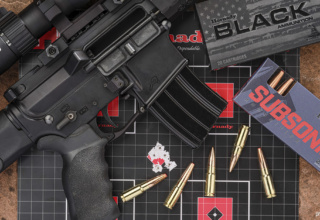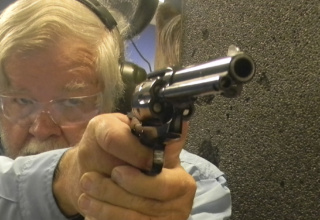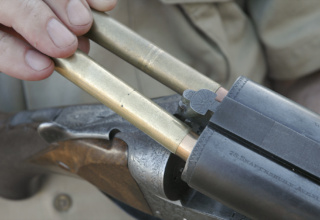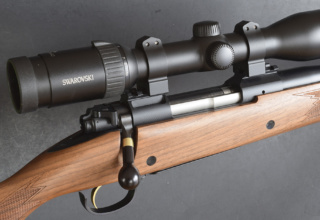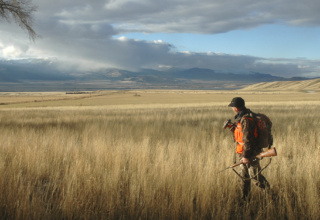Beyond the basic steps, producing superior ammunition at your bench is still easy!
by Wayne van Zwoll
The elk fell to a 180-grain Speer bullet driven by 69 grains of surplus H4831. The press that had sized my .300 H&H hulls cost $15. A graduate student renting a small trailer in an orchard and living on tomato soup, I’d anguished over sending Herter’s my check. Would handloads ever pay for that press?
Decades later, it has—many times over! Handloading saves money. Beyond that, it yields ammo you can’t get in a box. It’s a hobby, too—so absorbing, in fact, that you miss dinner, ignore the phone, and work that press into the night to try “just one more load.”
You’ll get excellent advice on handloading from manuals published by bullet companies. I’ll plug here my own “Shooter’s Bible Guide to Handloading” as well. Beyond basics, though, how can you make ammunition that trumps factory loads?
The short answer is, “You can’t.” Not always, anyway. Factory ammo has improved a great deal since I began shooting, and now includes many loads once available only from home benches. In 1964, a ballistics table of “average American-made rifle cartridges” listed 93 loads, .22 Jet to .458 Win. Mag. The current ammo roster from Hornady alone offers more than 250 factory loads!
Still, at home, you can fashion loads uniquely your own. You can “tune” ammo to suit your rifle. You can make cartridges factories don’t (I’m now loading for eight wildcat rounds).

Cartridges are purpose-driven. But whether for a 6mm BR in competition, a .223 to pester prairie dogs, or a .35 Whelen on a moose hunt, superior handloads follow much the same path.
First: mindset. You’re not just loading fresh powder and seating a new bullet. You’re manufacturing a new cartridge. Each one matters. Success at a match or afield can hinge on a single shot.

For hunting ammo and traditional rifle competition, you don’t need a progressive press. A simple C or O press that does one task at a time is still my choice for its simplicity and the control it affords.
Even new cases should be run into a sizing die. You’ll want to batch cases—new and fired—by brand. Variation in wall thickness affects pressure, velocity, and accuracy. Bench rest shooters weigh cases to ensure uniformity. Prepare 100 cases at a time so that, after culling, you have enough for load development.

Within practical limits, case length doesn’t matter as long as all cases are of the same length and their mouths don’t meet the chamber. Hulls too long are pinched at the mouth—a crimp affecting pressure and accuracy. You shouldn’t have to trim new or once-fired hulls, but checking length after a second use makes sense. Brass stretches upon firing. After trimming bottle-neck hulls to spec or a tad shorter, de-burr mouths lightly inside and out with a de-burring tool. (Straight, rimless cases that headspace on the mouth must be held to a specific length and kept square-lipped!)
Measure neck wall thickness with a ball micrometer. Disparities greater than .0015 around a neck beg outside turning. The Sinclair tool I favor has a centering mandrel and an adjustable blade you advance to shave the neck as you spin the case. Thick spots appear bright as they’re shaved. Stop when the entire neck is bright. A uniform neck grips the bullet with even pressure for a clean release. It also centers itself in the chamber and should enter minimum-dimension “match” chambers.

Cull cases with off-center flash-holes. Use a flash-hole deburring tool to trim the ragged lip inside that often results from punched holes. A depth gauge, set on the case mouth, helps you take just the burr.
Firing expands a case. Re-sizing returns it to original dimensions. Both “work-harden” the brass, shortening its life. There’s seldom a need to full-length-size a case to be used in the same rifle; you must only tighten the neck a bit to hold another bullet.
Neck-sizing is easy. With the die kissing the shellholder as for full-length sizing, back the die off the thickness of a penny. Now the die will squeeze the neck, and the expander button will open it, but the case won’t enter the die far enough to compress the body.
When handloads are destined for other rifles, actions with limited bolt-camming power (pumps and autoloaders,) double rifles, or dangerous-game hunts, full-length-sizing is best.
Lubing cases before sizing is an obvious requisite. A bare brass case can be well and truly stuck with a stroke of the press handle. If you manage to move the ram without bending or breaking something, you’ll pull the case in two. Then you’ll order a stuck case remover from RCBS and wait for FedEx.

Over-lubing is less troublesome but leaves hydraulic dents in the case shoulder.
Distribute a dab of lube with your fingers across a pad. Roll each case lightly. Use a nylon brush to lube inside the neck, to ease passage of the expander ball. Here, dry graphite trumps grease, which can grab powder grains and even affect ignition and bullet release. Dry the case necks after sizing.
You can seat primers in your press, but a hand-priming tool lets you better feel the primer bottom in the pocket, and it’s faster. If a primer feels loose going in, set that case aside for one last load or trash it. Expanded pockets follow high-pressure loads or many firing/loading cycles. Either way, the hull is near the end of its life. A primer leaving a case upon firing leaks gas that can harm you and your rifle.

The most important factor in choosing one powder from many is burn rate. Fast-burning powders are suited to short bullets in short, straight cases. Large bottleneck cases with long bullets mandate slow-burning propellants with sustained thrust. Gas-driven autoloaders beg powders that yield the proper level and duration of pressure at the port. “Closed bomb” tests rank burn rates, but these rankings can shift with changes in case capacity, bore diameter, and even bullet weight. The proliferation of powders has increased overlap and shuffling in relative burn rates.

Smokeless powders are either single-base (nitrocellulose) or double-base (with nitroglycerine). Nitro yields more energy per grain and reduces moisture absorption. Its liability: added residue. The extra oomph of double-base powders makes them useful where case capacity is limited.
Powder grains vary in shape. Spherical propellants like Winchester’s trademarked Ball series also include flattened, platter-shaped grains (all double-base). Extruded or “stick” powder grains are tubes. A hole in the center of each helps control the burn rate and pressure curve. Propellants whose grain surface shrinks during the burn are regressive. A surface that stays about the same size defines a neutral powder (think of a single-hole tube eaten away at the outer surface but also consumed from the inside out.) Large extruded grains have multiple holes to burn progressively. The holes more than offset outside shrinkage, so over much of its burn, grain surface area increases.
“Extruded powders are slightly more consistent over temperature ranges than spherical powders,” Chris Hodgdon told me. “But new spherical fuels show great consistency.” Hodgdon’s Extreme powders, introduced with Varget in 1996, show the least variation of any in the company’s stable.

Pointed bullets with tapered heels and long ogives look fast standing still and sell well. But for hunting, you’ll want bullets that upset reliably across a spectrum of impact speeds and penetrate without losing much weight. Starting shape matters little at the ranges most animals are shot. Bullets of traditional form—even round-nose missiles—may outperform sleek long-range bullets on game and deliver equal precision. Typically shorter, they’re easier to handload for standard magazines and they stabilize more readily in standard rifling twist.

To seat bullets, spin the seating die into your press a nickel’s thickness off the shellholder. Run the seating stem out so a stroke of the press handle barely sticks the bullet in the case mouth. From there, turn the stem down incrementally until you reach desired seating depth and overall cartridge length. The cartridge must clear the magazine and chamber easily without touching rifling lands. If neither of these are limiting, I seat a bullet out until it touches the lands then back it off .1 inch. Of course, you must have the bullet deep enough in the neck for a firm grip.
A rule of thumb: neck contact should equal bore diameter, so, a .30-06 or .308 needs .308 neck contact with the bullet shank.
Crimping isn’t necessary for most rifle loads, but it can prevent recoil-induced bullet movement in magazines of powerful rifles. Crimp only bullets with cannelures for that purpose.
Handloading may seem complicated, especially to the beginner, and you can certainly move deep into the weeds as your experience builds. But taking a deliberate and thoughtful approach to cartridge building puts the experience within reach of most shooters and hunters, with the results of increased accuracy, cost savings, and the satisfaction of a job well done as your reward.
Avoid Detonation!
Reduced charges of slow powder in big cases have produced rifle-rending detonation, presumably when primer flame flies across the top of the charge, initiating burn from front and back at the same time. Replicating this event has been problematic, but pressure waves appear to be the culprit. To throttle velocities, consider using a filler and/or slightly faster powder.
Beware the White Ring!
As a paper clip breaks when bent back and forth, a cartridge case fails when subjected to repeated expansion (firing) and compression (sizing). Discard cases showing incipient separation—a white ring in front of the extractor groove, where the web taper ends. Belted cases in generous chambers show this stretch ring earliest.




